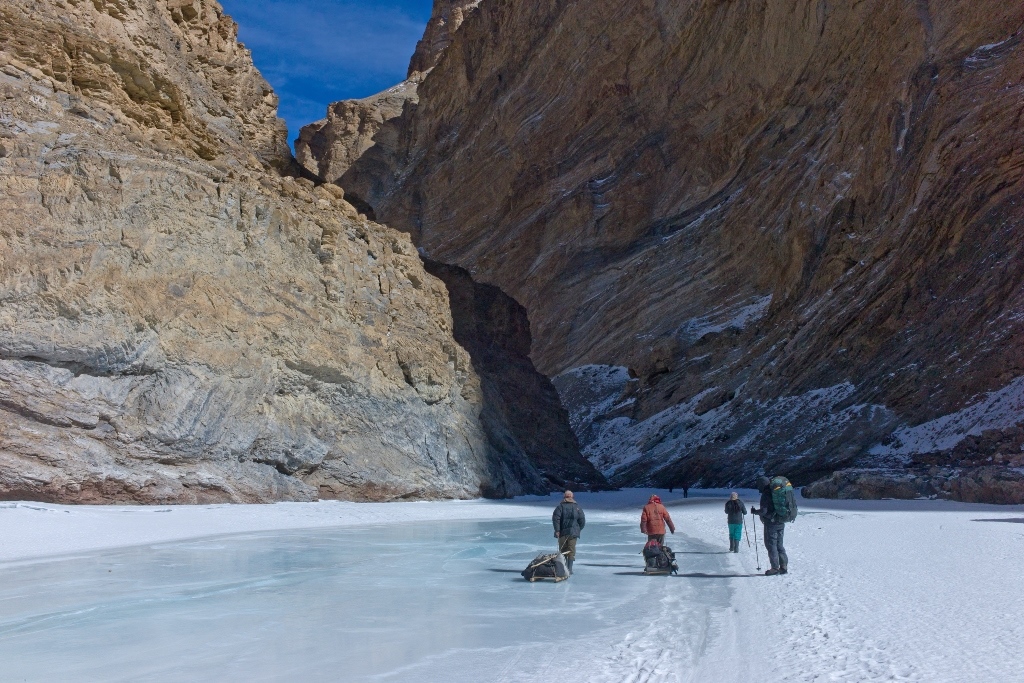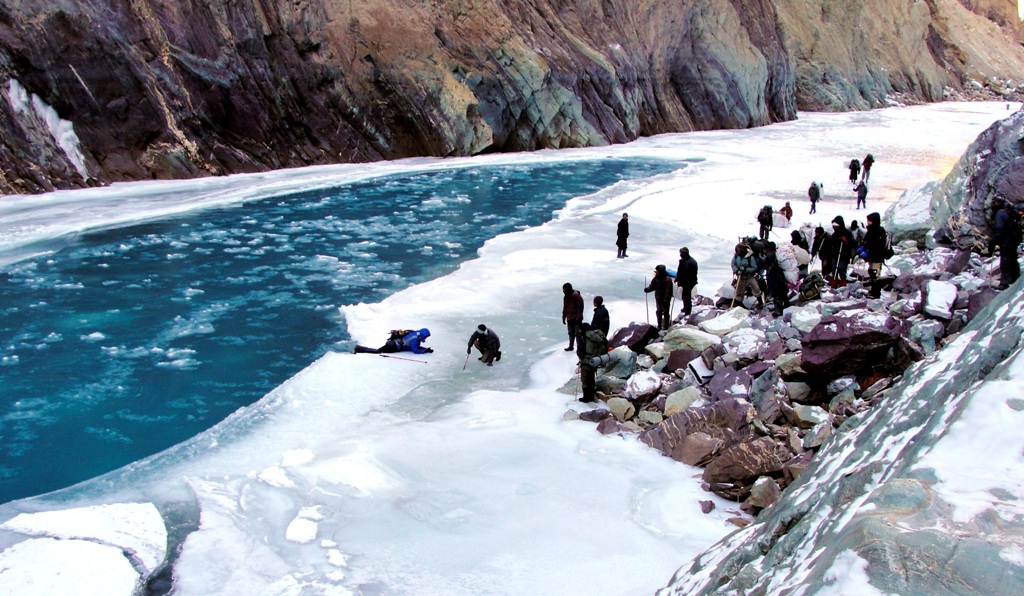Travel Goal 2019: Deadly Challenges of Chadar Trek
Tanya Roy
Latest posts by Tanya Roy (see all)
- Explore The Treks Nestled In Nepal: EBC And Annapurna - July 4, 2018
- Travel Goal 2019: Deadly Challenges of Chadar Trek - June 29, 2018
- Head Out To Himachal Pradesh: Beas Kund Trek, Bhrigu Lake Trek, Rupin Pass Trek And More - May 25, 2018
One of the most adrenaline-pinching, risque, thrilling explorations organised in the winter months(January-February) of every year is a trek on the frozen Zanskar river-Chadar Trek. The ice trail is a bold exploit even for the most advanced trekkers. Fluctuating and harsh weather over a frozen trail between ginormous golden mountains, this one is for the truly headstrong.
But it isn’t impossible! Far from it. The wild undertaking is carried out successfully by hundreds of trekkers every season. Through Naerak and Lingshed, the venturous make their way to the frozen river. Couple months of preparation and reliable information about the trek beforehand are their only friends. Of course, having a presence of mind and trekking gear in perfect shape are absolutely non-negotiable.

Before we go on to discuss what truly makes this trek so challenging, here’s what you should at least pack for the trip:
- Trekkers are also suggested to carry a pair of open-toe slippers, which one can wear around the campsite without wetting their socks
- Proper trekking shoes with high-rise ankle, waterproofing and insulation
- One size large pair of gumboots – a kind of boots for the purpose of wading through icy water
- Open toe slippers for casual wearing around the camp
- Two synthetic trek pants
- One windcheater
- Two pairs of upper and lower body thermal wears
- Two warm pants
- Two full sleeved collar t-shirts
- 1 down jacket
- 1 fleece jacket
- 3 pairs of merino trekking socks
- Four pairs of undergarments
- 1 complete body raincoat
- Woollen gloves and synthetic waterproof gloves
- Woollen cap that covers the ears
- Woollen socks for sleeping in the night
- Woollen stole or balaclava to wrap around the neck.
- Lip balm
- Sunscreen
- Cold cream
- Toothpaste
- UV protection sunglasses to prevent snow blindness
- Trekking pole
- Head torch
- Daypack
- Rucksack with a capacity of 50 to 60 litres
- Medicine kit
- Insulated water bottle and thermos flask
- Utensils
- Packaged refreshments
- Plastic sealable polythene bags, which can keep items dry and safe

Know It All: The Multi-fold Challenges of Chadar Trek
One will always face the mind-blowing challenge of walking on a thin ice sheet which may break at any time and thrust you in the icy cold water at around -25 degree Celsius temperature. Apart from this challenge, there are some other challenges as well that one may have to face:
- Acute Mountain Sickness: According to a report, around 15 trekkers are reported to have been hospitalized in 2018, due to symptoms of AMS such as nausea, vomiting and breathlessness. During Chadar trek, trekkers can trek up to 11,123 feet. This sudden change in altitude may affect one’s body, thus failing him from accomplishing the trek. In order to prevent such as thing, trekkers are advised to first stay in Ladakh for a few days before starting the trek. This will enable one’s lungs to adjust according to the change in altitude. This time can be fruitfully used by taking acclimatization walks by trekkers.
- Constant change in trekking trail: As a major portion of Chadar trek is covered over the frozen icy path formed by Zanskar River, the slightest of change in temperature has an extreme impact on the frozen trail of Chadar trek. It is highly suggested that travelers should pay attention to all the commands and instructions of the team leader and trek on only sledge routes. During an average day, the frozen river undergoes a constant process, which involves the formation of new ice sheets, melting of old ice and irregular breaking of ice blocks. During Chadar trek, travelers will always find the frozen river in a different condition. At times, the whole river will be completely frozen and its surface will be suitable to walk. At other times, the frozen stream of ice will completely melt from the center portion, thus leaving only narrow side trails of ice to walk on. There will also be times when the river would completely melt and the trekkers would have to leave the melted stretch of the river and climb the mountains. When there won’t be an option to climb the rocks, trekkers would also have to wade through the cold slushy stream of the river. It is suggested that trekkers should walk in small packs comprising of 6 to 7 people along with a person, who has all the necessary equipment including rope, carbines, harnesses, slings, a throw bag, sleeping bag and is ready to handle any kind of worst-case scenario. In case a trekker falls into the deeper portion of a running stream, he or she should prevent flowing along the stream. In such a case, a leader would throw a throw bag end, so that the drowning person may grab hold of it and get saved. In order to prevent such a situation, trekkers can opt to get anchored with the leader, who will be attaching all the trekkers by rope to his or her anchor.
- Extreme cold conditions: The excessive cold conditions during Chadar trek often result in causing hypothermia to trekkers. Hypothermia occurs due to lack of warmth within one’s body. Usually, during a trek, hypothermia sets into one’s body after he or she has worn wet clothes for a long duration or even during the sleeping hours. People having weak bones should refrain from opting to go on this trek as the slippery icy terrain leads one to fall numerous times. Also, people with any kind of serious heart condition are also prone to hypothermia. The cold weather during the trek shrinks the blood vessels in one’s body, thus causing an immense pressure within the heart and leading to hypothermia in people with serious heart conditions. In order to tackle the issue of hypothermia, a trekker is required to be constantly active and warm during the Chadar trek. During the day, trekkers should constantly keep their body in motion, which will help in keeping themselves warm. It is suggested that trekkers at camping site should perform activities such as exploring campsite, interacting with locals or even playing some sports on the icy field. Trekkers are required to bring warm clothes which may protect them from snow blizzards and avalanches.

Image Credits: planetwayround.com
IN THE UNLIKELY SCENARIO OF A DROWNING:
- Shout at your loudest to attract attention.
- Seek hold of the bank and staying glued to it.
- In the case of getting dragged away, travelers can hold on to their bags and place it above their chests as it will help them stay afloat.
- If a drowning traveler in a running current of the river is unable to reach the surface, he or she should look for a whirlpool in the river.
- Once the traveler gets rescued from the river, it is necessary to remove all wet clothes at once.
- In case a traveller gets hypothermia, he or she can try to get warmth from sleeping bags and hot water bottles.
- In case a traveler is in a serious case, the support staff should set up a tent and arrange warm stoves for warmth.
Are you still reading?
You have already won half the battle if you are well equipped with information because now you know what to expect. And come on, all this risk is what makes Chadar trek an absolute thrill! If you play by the rules, you will never forget this once-in-a-lifetime experience.



Comments